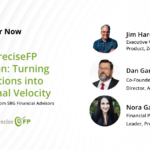Clients often don’t know what they don’t know. Their understanding of security risks is usually shaped by snippets from social media and alarming news stories, which can lead to unnecessary panic. At the same time, there are critical risks they may not even realize they should be concerned about.
As a fiduciary, it’s your responsibility to stay ahead of these concerns by making your stance and best practices clear. While conversations about hackers and security breaches can be uncomfortable, transparency is key to building trust. Clients want to feel reassured that their money and information are safe, even when discussing what could go wrong feels counterintuitive.
Start With Risk Management Basics
Mitigating financial risk is a complex subject many spend years learning about. When having conversations with clients, though, address the real concerns most clients have when entrusting their money to a third party. Approaching discussions about risk management through an empathetic lens can reassure clients that you care enough about their financial well-being and understand where they’re coming from. It also sets the foundation for an honest working relationship that can help you make the most beneficial decisions for your clients.
Avoid jargon and invite clients to be active partners in investment decisions. Using clear and concise terminology to describe your firm’s approach to risk management also helps clients recognize its importance. It can also empower clients to understand — at least, on a high level — how their information is protected and any general procedures in place for minimizing risk.
Technical, real-world examples can help showcase your firm’s risk management policies. Overall, the most important thing is to start with the basics: if you were in your clients’ shoes, what would you want to know about how your information will be kept safe?
Get The Right Information To Make The Right Investment Decisions
Another way to organically include risk management in client conversations is by infusing it into the portfolio planning process. Before recommending investment options, understand clients’ preferences and long-term goals.
Some common questions to ask clients include:
- How would you like your financial situation to look within the next 5 years? 20 years?
- What kinds of companies/organizations would you like to buy shares in? Do you value environmental sustainability? Consistent stability in the market?
- How comfortable are you with taking investment risks?
- What are your plans for retirement? What kind of monthly income do you want available after you retire?
As part of the same discussion, advisors can tie in risk management with their investment recommendations. Based on client answers, tailor risk management discussions toward topics and threats pertinent to each person. Being transparent with this strategy will build client/advisor rapport and mutual trust.
Invest In Technology That Can Help Mitigate Risks
Discussing risk management with your clients isn’t effective if you don’t have the time or resources to properly secure their information. Investing in technological solutions that identify, remediate, and document risk gives advisors more time to provide personalized investment advice.
Involving clients in building out a comprehensive risk management plan can help them see how the right platforms and processes mitigate risk. Knowing who is accountable can reassure hesitant clients that you have an actionable plan for addressing any threats that may arise.
No risk management plan is perfect. However, informing clients about the dangers that can get through even the most robust security system provides them some agency in the level of risk they feel comfortable with.
Protecting your clients’ privacy and information is one of our top priorities. In today’s world, data security is essential to building trust and maintaining strong client relationships.
Many clients want to know how their information is being protected. To provide clarity and reassurance, we offer a client-facing document that outlines the measures we take to keep their data secure.
Here’s how we protect client information:
- Encryption: We use 256-bit SSL data encryption and intrusion detection for top-level security.
- Authentication: High-security forms require SMS, email, or password authentication.
- Routine Audits: Regular security audits and testing ensure our systems stay secure.
- Non-Transactional Data: Financial information is stored at a high level, with sensitive fields encrypted for extra protection.
These practices help keep your clients’ data safe while giving them the confidence to trust you with their most important information.
Start your free trial today and see how we can help you prioritize privacy and security.











